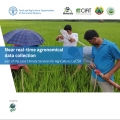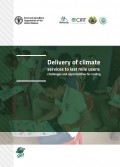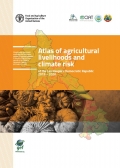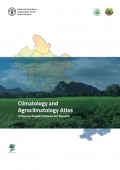Publications

2022
The leaflet presents the tool used in the Laos Climate Services for Agriculture (LaCSA) to collect agronomical data in near-real time. Under the collaboration with FAO, the data are now used as part of the LaCSA to produce climate services for farmers at weekly and monthly intervals. Near real-time agronomical data includes sowing, flowering, harvesting and pest and disease information. Input forms and incidence reports are also presented. In addition, the leaflet also explains how the new tool helps with strategic crop management, to improve the capacities of farmers at the local level, and to leverage proactive farming practices. Finally, the leaflet explains how government entities and national and local NGOs who work in agriculture promotion can use this information for capacity building and rural development programs.

2022
This book describes the challenges and opportunities for scaling up delivery of climate services to last mile users and describes the baseline assessment results of the project “Strengthening Agro-climatic Monitoring and Information Systems (SAMIS) to improve adaptation to climate change and food security in Lao PDR”. After a methodological introduction, the book describes how households were accessing weather news. Further to this, the use of loudspeakers as a source of weather information is described, including use of weather news from loudspeakers, use of weather information, challenges to use of advisories, suggestions for improving advisories, sources of support for farmers, and type of support provided to farmers. The book also studies the farmers who did not access advisories, including their challenges in accessing advisories from loudspeakers, preferred channels for receiving advisories, and interests in loudspeaker-delivered advisories from farmers who have not accessed advisories. Finally, the book analyse suggestions for improving dissemination through loudspeakers. The results show that loudspeakers have a wide reach and are valued by farmers, and it is used when choosing crop variety. Those who have access to both farmer field schools and loudspeakers are more likely to adjust their planting schedule, while farmers who get their information only from loudspeakers often change their water management practices.

Atlas of agricultural livelihoods and climate risk of the Lao People's Democratic Republic 2019–2020
2022
This Atlas presents the first national dataset on livelihoods and the farmers capacity to adapt to climate change in the Lao People's Democratic Republic. Maps included in the Atlas include the satisfaction of farmers’ basic needs, farmers’ access to the resources needed for innovation and the farmers’ capacity to translate innovation into action. The landscape characteristics mapped include attitudes towards livelihood-related change, economic activity, soil fertility, supporting infrastructure, food security issues, water security, institutional support and extension services, access to climate information through information and communication technologies (ICTs ), market access vis-a-vis production orientation, use of and access to agricultural inputs, livelihood diversification, and dependency on agriculture, including the rearing of livestock and fish. The dataset has been generated using an innovative method that combines participatory mapping and advanced data analysis, and which is, both in terms of technical standard and scientific innovation, state-of-the-art. The livelihood data is available online in the Land Resources Information Management System thanks to the work of two collaborating teams: "Applying seasonal climate forecasting and innovative insurance solutions to climate risk management in the agriculture sector in Southeast Asia” (De-Risk) project, implemented by CIAT; and the "Strengthening Agro-Climatic Monitoring and Information Systems (SAMIS)" project, implemented by FAO.

2022
This atlas is a study of climate and agroclimate in the Lao People’s Democratic Republic for the period 1990–2019 based on the downscaling of long-term observation data. It has been produced as part of the “Strengthening Agro-Climatic Monitoring and Information Systems (SAMIS) to improve adaptation to climate change and food security in Lao People’s Democratic Republic project. It aims to support the achievement of the Lao government’s priority targets, as set out in the country’s Ninth National Socio-Economic Development Plan (2021–2025).The Department of Meteorology and Hydrology (DMH) is the main body responsible for the national climate database and producing climate statistics. The Department of Agricultural Land Management (DALAM) also provided expertise in the use of advanced downscaling technologies. This Atlas presents the results of the work carried out by these bodies. The information describes in detail the country’s climate and how it has changed over the last 30 years.
2021
The leaflet presents the activities of the second component of the project “Strengthening Agro-climatic Monitoring and Information Systems (SAMIS)”. In collaboration with the Department of Agricultural Land Management (DALaM) under the Ministry of Agriculture (MAF) has, with the financial support of FAO Laos and technical support from the Asian Institute of Technology (AIT) and FAO experts, produced the national level agro-ecological zoning (AEZ) mapping process. The AEZ aims to define the potential use of zones where crops can be growth based on climate, soil, crop cycle, and crop management practices, resulting in maps of suitability and potential yields. The maps have been generated using a software, called pyAEZ, produced with the project's support. The suitability maps for today and the future, using climate scenario as an input, are, in both technical standard and input data quality, state of the art. Lao People’s Democratic Republic is the first country, globally, to implement the AEZ system using national data and national capacity exclusively. The SAMIS AEZ delivery model has shifted demands for expertise to the regional and local levels.The AEZ allows policymakers to look ahead and adjust policies now to prepare for climate-related changes that will affect the prosperity of the country. Also, it helps to assess alternatives for future cropping systems and it guides establishing priority crop plan and future-proof land allocation to specific crop productions. Ultimately, the results from the scenario modeling will be uploaded to the Land Resources Information Management System (LRIMS).
